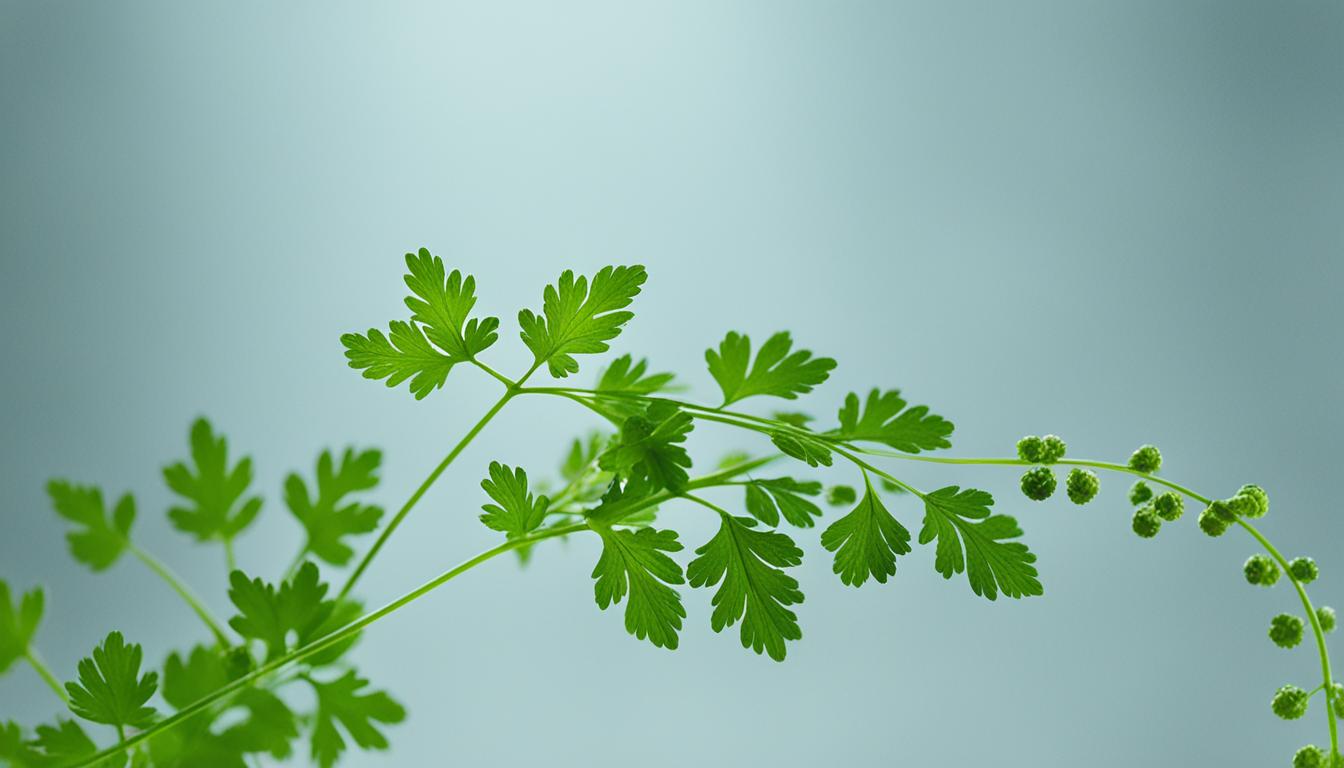I love exploring the unique flavors that herbs add to dishes. Chervil, a relative of parsley and cilantro, caught my eye. It has a bright green color and tastes like a mix of parsley and tarragon. This makes it a key ingredient in the delicate herb for French cuisine.
Chervil’s light scent and gentle taste make it perfect for many gourmet dishes. It’s great as a final touch, adding a hint of licorice that brightens flavors.
Chervil is also good for you, offering health benefits of chervil. It’s full of antioxidants and vitamins, making it a healthy choice for meals.
As a home gardener, I enjoy growing chervil at home: tips for a thriving herb garden. It’s easy to grow indoors or outside. This makes it a great addition to any herb garden, giving me fresh chervil for my cooking.
Next, we’ll look closer at chervil’s unique taste and how to use it in gourmet cooking. Let’s explore the world of chervil together and discover its magic.
Unveiling the Exquisite Flavors of Chervil
Chervil is a delicate herb known for its amazing smell and taste. It’s a key part of French cooking. Its taste is a mix of parsley and tarragon with a hint of licorice. The leaves are bright green and have a short, sweet scent. Add it to dishes just before serving to keep its flavor.
Chervil’s Unique Taste Profile
Chervil’s flavor is a mix of parsley and tarragon’s aromas. This makes it stand out in the world of the delicate herb for french cuisine. It also has a licorice-like taste that adds depth to dishes.
Culinary Applications of the Delicate Herb
Chervil is versatile and can be used in many dishes. It’s great in egg dishes, salads, soups, sauces, and with poultry. This herb brings health benefits of chervil to your meals.
Chervil is perfect as a garnish, flavor booster, or a main ingredient. Its special qualities make it a must-have in French cooking. It’s known for improving and enhancing many foods.
The Versatile Companion: Chervil in French Cuisine
I love exploring French cooking and always find something new to learn. Chervil is a herb that really stands out to me. It’s a key part of French cooking, adding a special touch to dishes.
Chervil is part of the “fines herbes” mix, along with tarragon, chives, and parsley. This mix is used in many French dishes, like meats, veggies, soups, and sauces. The delicate herb for french cuisine adds a special flavor that makes dishes better.
“Chervil is the unsung hero of French cuisine, adding a whisper of flavor that can transform a dish from good to great.”
Chervil makes a big difference, whether it’s in a simple omelette or a complex dish like boeuf bourguignon. It goes well with creamy sauces, which are a big part of French cooking. Chervil can work with many ingredients, making it a must-have in French cooking.
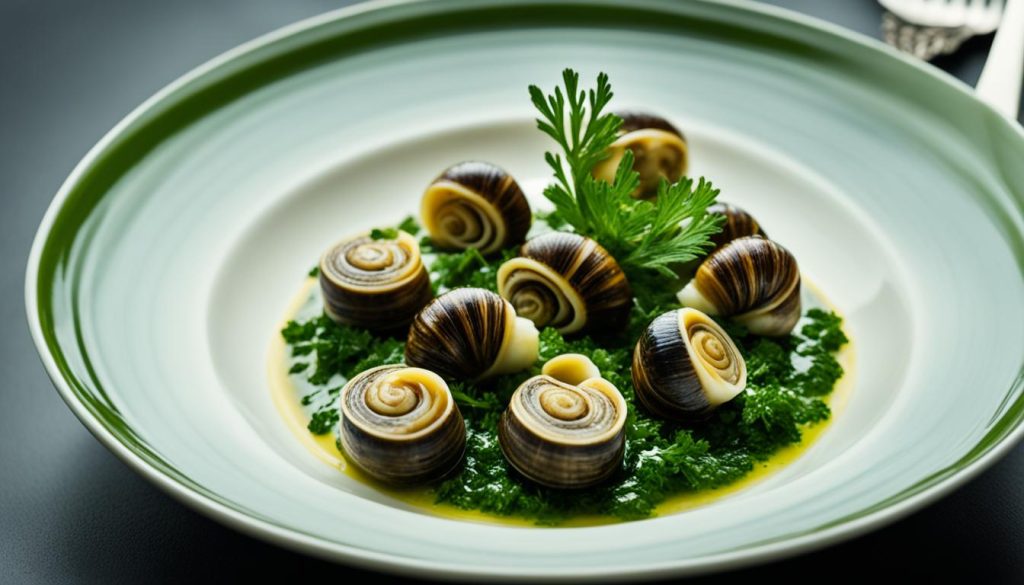
Every time I try new French recipes, I use chervil. It can make even simple dishes taste amazing. The delicate herb for french cuisine is a key part of French cooking. Its subtle taste and versatility make it a favorite in French kitchens.
Chervil: A Delightful Addition to Egg Dishes
Chervil makes classic egg dishes taste better. Its subtle licorice taste and fresh flavor go well with eggs. This makes breakfast and brunch more exciting.
Elevating Omelets and Scrambles
Omelets and scrambles are great for chervil. Add it at the end of cooking to keep its fresh taste. This herb makes the eggs taste amazing.
- Chervil’s bright, herbaceous notes complement the richness of eggs.
- The herb’s subtle licorice undertones add depth and complexity to egg dishes.
- Chervil’s delicate flavor shines when added at the end of cooking, preserving its fresh, aromatic essence.
“Chervil is the unsung hero of egg dishes, adding a refined touch that elevates these breakfast and brunch staples to new levels of sophistication.”
Adding chervil to omelets or scrambled eggs makes them special. It brings a unique taste that makes you happy.
Chervil: The Delicate Herb for Gourmet Cooking
Chervil is a gem in French cooking. It has a unique taste that’s fresh and slightly like licorice. This makes it great for many dishes. It’s perfect for salads, soups, or sauces, adding a special touch.
Chervil is special because it doesn’t overpower other flavors. It’s subtle and adds balance to dishes. It’s great with vegetables or poultry, making them taste better.
Chervil’s flavor and smell are why it’s loved in gourmet cooking. It makes dishes taste better and is essential for cooks at home or in restaurants. Try using the delicate herb for french cuisine and see the difference it makes.
“Chervil is the unsung hero of gourmet cooking, adding a delicate touch of elegance to every dish it graces.”
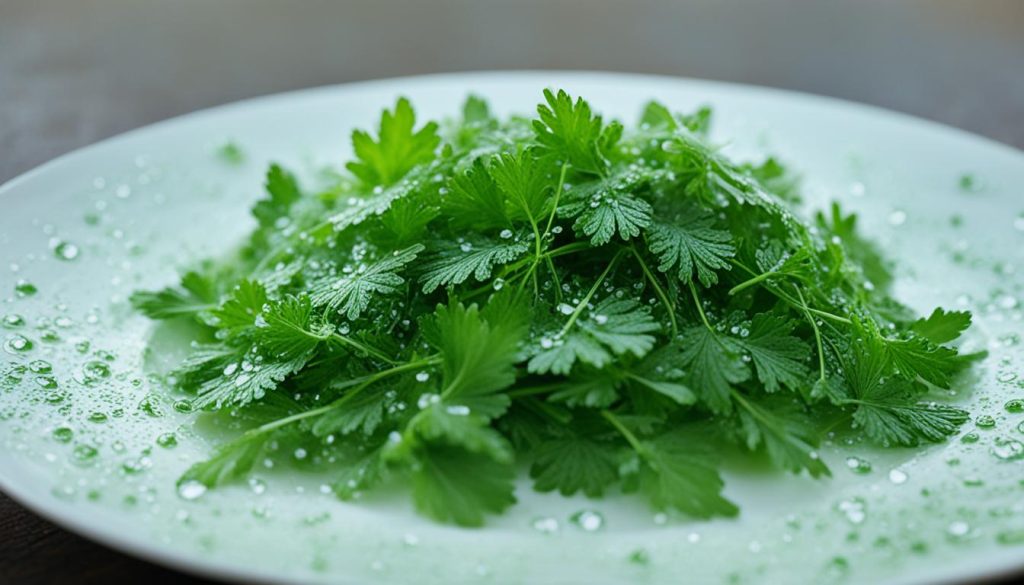
Mastering the Art of Using Fresh Chervil
Using fresh chervil in cooking needs a gentle touch. Its aroma and flavor can fade easily if not handled right. Add it near the end of cooking to keep its unique scent and taste.
Tips for Preserving Chervil’s Aroma
Storing chervil right is key to keeping its aroma and freshness. Here are some tips:
- Keep chervil in an airtight container in the fridge, away from sunlight and heat.
- Pat the leaves dry with a paper towel before storing to remove extra moisture.
- Use chervil within a day or two of buying or picking for the best flavor and smell.
- Don’t pack the container too full, as this can cause the herb to wilt and spoil faster.
With a bit of care, you can become a pro at using fresh chervil. These simple tips will help you enjoy the bright taste and smell of growing chervil at home. You’ll create a beautiful herb garden that adds gourmet flair to your meals.
“The secret to using fresh chervil is all in the timing. Add it at the last minute, and you’ll be rewarded with a burst of delicate flavor that will elevate your dish to new heights.”
Growing Chervil at Home: A Gardener’s Delight
Growing chervil at home is rewarding and fun. It’s a cool-weather plant that loves early spring and partial shade. With simple care, you can have fresh chervil for your cooking.
Cultivation Techniques for a Thriving Herb Garden
Start chervil indoors and then move it to a pot or garden bed. This way, you avoid the trouble of moving it later. Chervil prefers staying in one place.
- Provide the right amount of sunlight: Chervil likes partial shade, so pick a spot with 4-6 hours of sunlight a day.
- Maintain consistent moisture: Keep the soil moist but not too wet. Water the plants often, especially when it’s dry.
- Protect from frost: Chervil can’t handle frost, so cover the plants or bring them inside when it gets cold.
- Harvest frequently: Cutting the leaves often makes the plant grow more. This way, you’ll always have fresh chervil.
By following these tips, you can enjoy chervil’s fresh taste in your cooking all season.
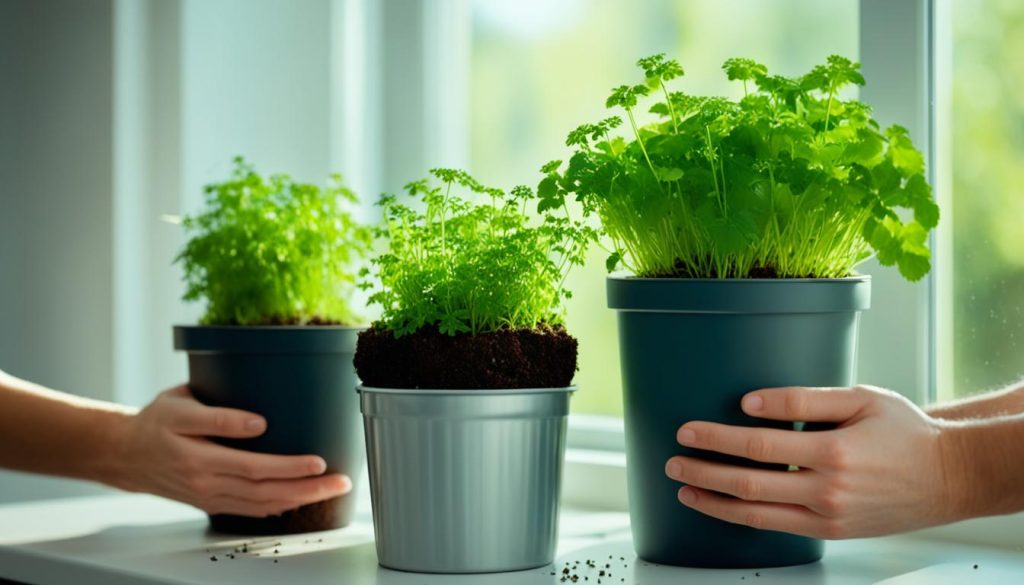
Exploring Chervil’s Health Benefits
I love the smell and taste of chervil. But it’s more than just tasty. Chervil is full of health benefits, making it great for any kitchen.
Chervil is packed with antioxidants. It has vitamins A, C, and K, and minerals like iron, calcium, and magnesium. These help fight off harmful free radicals and keep cells healthy.
- High in antioxidants
- Rich in vitamins A, C, and K
- Excellent source of iron, calcium, and magnesium
Chervil also has anti-inflammatory properties. This is good news for people with arthritis or stomach problems. Adding chervil to your meals can help your body fight inflammation and stay healthy.
“Chervil is a hidden gem in the world of herbs, offering not only exquisite flavors but also a wealth of health benefits.”
We need more studies to know all about chervil’s health benefits. But what we know is, it’s a great choice for a healthy diet. So, next time you’re thinking about chervil, remember it’s good for your health and tastes great too.
Dried vs. Fresh: Which Chervil Reigns Supreme?
I love the delicate herb for French cuisine and often think about the debate between fresh and dried chervil. Fresh chervil is better for unlocking its true flavor. It’s more available, but fresh is the top choice.
Fresh chervil has a light, almost magical smell that dried chervil can’t match. Its taste is subtle yet complex, making it a key ingredient in French dishes. Dried chervil lacks the depth and complexity of fresh chervil.
| Attribute | Fresh Chervil | Dried Chervil |
|---|---|---|
| Aroma | Delicate, perfume-like | Muted, less pronounced |
| Flavor | Subtle, complex | Less nuanced, flat |
| Culinary Applications | Enhances delicate dishes | Limited versatility |
Chefs and cooks say to use fresh chervil when you can. It makes dishes better. But, fresh chervil might not always be easy to find. If not, mixing parsley and tarragon can be a good substitute, but it’s not the same.
“Fresh chervil is the true star in French cooking, elevating even the simplest of dishes with its unparalleled aroma and flavor.”
For me, fresh chervil is the best. It adds elegance and refinement to many dishes. While dried chervil has its uses, nothing beats the real thing.
Delightful Recipes Showcasing the Magic of Chervil
Chervil is a key herb in French cooking. It adds a bright, herbaceous flavor to many dishes. Use it in salads, soups, sauces, and egg dishes to make them special.
Chervil’s subtle licorice taste goes well with fresh greens and light dressings in salads. You can use its leaves as a garnish or mix them in. This adds elegance and flavor to your salad.
Chervil is great in soups and sauces too. It balances rich ingredients with its refined taste. Whether it’s creamy soups or tangy vinaigrettes, chervil makes them better.
Chervil loves egg dishes. In omelets and scrambles, its licorice flavor matches the eggs perfectly. This creates a tasty and harmonious dish.
| Dish | How Chervil Enhances It |
|---|---|
| Salads | Bright, herbaceous notes that balance the freshness of greens and vegetables |
| Soups and Sauces | Refined flavor profile that can balance out richer ingredients |
| Egg Dishes | Subtle licorice flavor that complements the creaminess of eggs |
“Chervil’s delicate nature makes it a true gem in the world of gourmet cooking. It has the power to transform even the simplest dish into a culinary masterpiece.”
Mastering the Art of Pairing Chervil with Other Ingredients
I love exploring the versatility of chervil, a delicate herb. Its flavor is both fresh and slightly sweet, perfect for many dishes in French cooking. Learning to pair chervil with other flavors can make any dish special.
Chervil pairs well with other herbs like tarragon, chives, and parsley. Together, they make a mix called “fines herbes.” This mix has a balanced taste. Chervil softens the strong tastes of the other herbs, letting each one stand out.
Chervil also goes great with meats. It brightens up dishes like roasted chicken or seared salmon. Its taste can also balance rich sauces. Plus, it adds a special touch to eggs, making omelets and scrambles taste better.
Knowing how to pair chervil with other ingredients brings out its best in cooking. Whether in a traditional French mix or as a special touch in a meal, chervil makes flavors pop.
| Ingredient | Pairing Suggestions with Chervil |
|---|---|
| Herbs | Tarragon, chives, parsley (classic “fines herbes” blend) |
| Proteins | Chicken, salmon, eggs |
| Sauces | Creamy sauces, butter sauces |
| Vegetables | Carrots, potatoes, green beans |
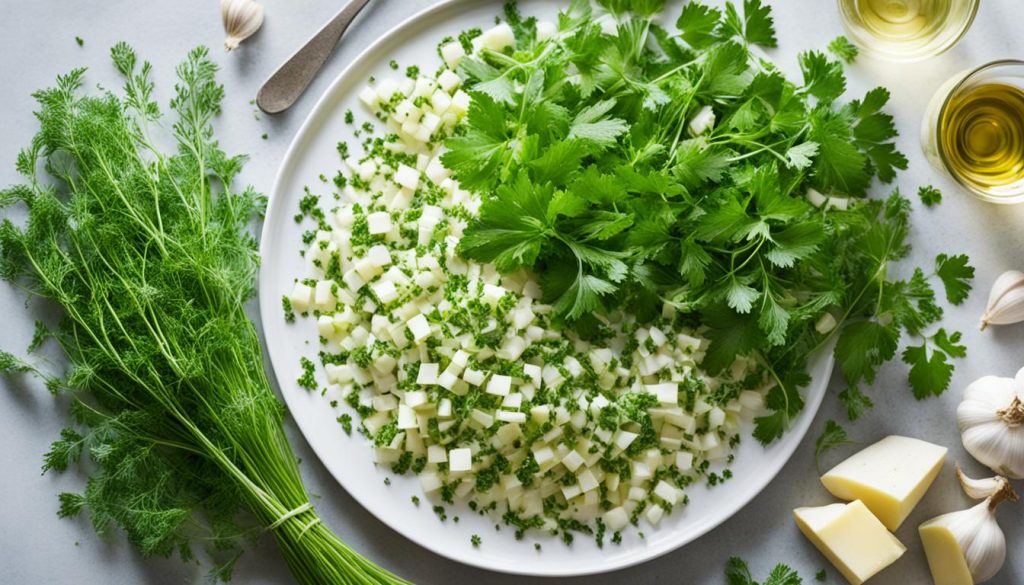
Chervil is a joy to cook with because of its light flavor. By learning how to match it with other ingredients, cooks can create amazing dishes. This can take their cooking to a new level of taste and style.
Chervil: The Unsung Hero of Gourmet Cooking
I love cooking at home and I’ve found chervil to be amazing. It’s a herb that’s not often talked about but it can really make a dish special. It’s perfect for adding a unique taste to many dishes, from French cuisine to new recipes.
Chervil is great for adding a fancy touch to dishes. It’s also perfect for sauces and soups, adding a fresh, herb flavor. When used with egg dishes, it brings out their subtle tastes. Its unique flavor is hard to find in other herbs, making it a top choice for cooks.
Being health-conscious, I like that chervil is good for digestion and full of vitamins and minerals. Growing chervil at home is also rewarding. It shows the joy of growing a herb garden and the beauty of gourmet cooking.

